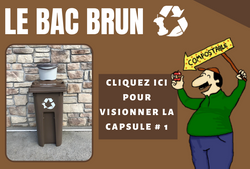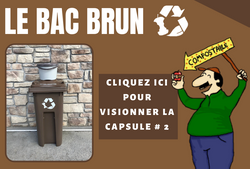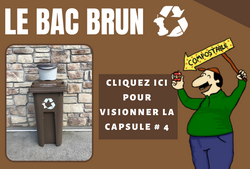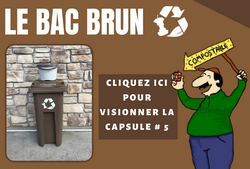Garbage - Recycling- COMPOSTING
 |
 |
 |
 |
||
Did you know ?
On average, a Canadian household throws away 1100$ worth of food each year. Composting is an excellent way to divert thousands od tons of resiusal materials from landfill. It also contributes to reducing our disposal costs and greenhouse gas emissions.
.
8 Good reasons to compost?
- One of the main objectives of the Quebec residual materials management Policy (2010-2015)is to reduce household garbage by 60% by 2023.
- Organic matter constitutes about 40% of the waste generated in the Gatineau Valley.
- Transporting waste and landfill management is very expensive.
- Composting will divert more than 2,300 tons of residual materials from landfill.
- Composting contributes to the reduction of greenhouse gas emissions.
- We have an organic matter processing site in our own MRC Vallée-de-la-Gatineau.
- Compost produced at the composting centre is nutrient rich and can be used as an organic fertilizer.
- The composting centre is a great complement to home composting, since it can process many materials such as meat, cardboard and paper fibers that are not recommended or difficult to compost at home.
Collection information
- All bins should be road-side no later than 7:00 a.m. on pickup day.
- Collection takes place between 7:30 a.m. and 4:30 p.m. If there is a problem and your compost is not collected, call us at (819) 465-2323 ext. 121.
- Wheeled bins must not obstruct traffic or constitute an obstacle to snow removal during winter. It is the responsibility of residents to ensure the maintenance and snow removal of the bins and of their road-side placement site.
Collection frequency
On public roads:
From the beginning of May to the end of October, the service will be carried out every week.
From the beginning of November to the end of April, collection will take place every two weeks
To find out the collection days in your area, please refer to the waste, recycling and compost collection calendar
On private roads:
We are presently working on the development of a service for owner that are currently served by the pick-up.
Green residu collection
You can dispose of your green yard waste during these special collections that will be annouced ou identiied on the calendar. During these collect, your green yard waste can be placed outside of the bin in a paper bag
The brown bin
Accepted containers
A wheeled brown bin and a kitchen bin were dilivered to all occupancy units served for the compost collection.
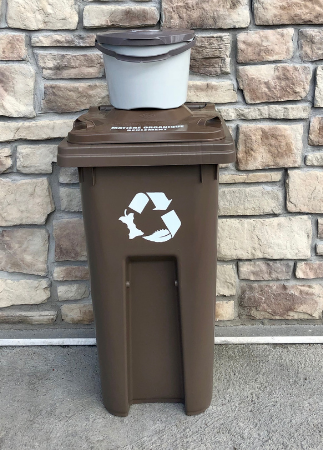
You can use brown paper bags provided for this purpose iun your kitchen bin as well as the larger size for the wheeled bin. You can also make a bag for the small kitchen bin from newspaper or flyers. See video. No plastic bags should end up in the brown bin, including those marked biodegradable, compostable ou oxobiodegradable.
Bin storage
Wheeled bins must not obstruct traffic or constitute an obstacle to snow removal during the winter. It is the responsibility of residents to ensure the maintenance and snow removal of the bins and of their roadside placement site.
After collection bins must be returned to their storage location near the house. In special cases, (e.g. a residence located at the end of a private entrance the length of which is 60 metres or more), the occupants of the building may store their bins closer to roadside but they must be kept a minimum distance of 15 metres from public or private roads. Wheeled bins must be stored so that they are not visible from the roadway.
Under no circumstances may bins be stored along public roads.
For more information, refer to by-law 2010-280 "Règlement régissant la cueillette, le transport et la disposition des matières résiduelles". (french version only)
Bin purchase, maintenance and repair
Bins are available at the municipal office and at hardware stores. If you plan to deal with a hardware store, it is essential to purchase the right type of bin compatible with the automated mechanism of our collection trucks. The support arms on the bins are designed according to one of two existing systems. Wheeled bins used in the Municipality of Messines must be of the European type. See picture. If your bin does not meet this criteria, we will be unable to transfer its contents to the recovery truck.
If you have a problem with a bin, spare parts such as wheels, axles and lids are available at the Municipal office. Broken or defective bins are difficult to manipulate and may not be able to be emptied by the collection team.
It is important to clean the inside and outside of your bin on a regular basis. This will reduce odours and help in the transfer of the material to the collection trucks.
If you think your bin has been stolen, please notify us as soon as possible. Every municipal bin comes with a serial number corresponding to a specific residence.
Tips and best practices
Composting tips and best practices
- Place your kitchen bin in a strategic location, near the trash for example. Keep the collection schedule visible nearby.
- Use a brown paper bag or place newspaper in the bottom of the kitchen bin to absorb liquids - NO PLASTIC BAGS including those labeled "compostable", "biodegradable" or "oxo-biodegradable" should be used for your bins. See the video section for a tutorial on how to make a bag for your kitchen bin out of newspaper.
- Wrap meats, dairy products and other potentially malodourous food waste in newspaper
- Empty your kitchen bin directly into the large brown bin as soon as it is full.
- During the winter place cardboard or dead leaves at the bottom of your bin to prevent the contents from freezing and sticking to the bottom.
- During the summer keep malodorous items in the freezer and wait until collection day to put them in the brown bin.
- Wash and rinse your kitchen and brown bins to keep them clean and odour free. Occasionally sprinkle the bins with baking soda or vinegar.
Already composting at home?
Use both methods! Continue to compost as usual but use the brown collection bin to dispose of items that cannot be put in your current compost bin including meat, fish, bones, fat and skin, leftover food containing fat or dairy products, soiled, unwaxed boxes and packaging and excess green yard residu.
Complementary solutions to composting
Two simple, fast and ecologically beneficial practices: leaf and grass cycling.
Grass cycling and leaf cycling are simple and effective ways to return organic matter to the soil. Simply leave grass clippings and shredded leaves directly on the ground. As the leaf litter decomposes, nutrients are released into the soil increasing its fertility and giving it a stronger structure.
For this same reason leaves and twigs are often added to compost piles.
Why wouldn't the grass be greener on your side of the fence?
Brown bin items
Edible? - Paper ou cardboard? - Lawn and garden? |
|||
Permitted |
Prohibitted |
||
packaging |
|
||
|
Green yard waste Leaves, grass, flowers, plants, weeds, twigs, sawdust, shavings, and bark |
Other
Construction and renovation materials |
||
|
Fibres
|
|||
|
Other Hair, cold ashes, litter box residue and animal droppings |
|||
Green yard waste
Green yard waste collection:
You can dispose of your green yard waste during special collections. They will take place in the spring and fall and will be identified on the collection calendar.
During these collections, your green yard waste can be placed outside the bin in a paper bag. Green waste placed in plastic bags will not be picked up.
POPULAR QUESTIONS
Organic materials decompose in the landfill. Why can't I put them in my garbage bin?
It is true that organic materials will decompose when they are thrown in the garbage. However, since they are buried, the lack of oxygen during their decomposition creates harmful greenhouse gases such as methane. Methane has a much higher atmospheric warming potential than carbon dioxide. When we put our organic materials in the brown bin, the presence of oxygen during the composting process prevents the production of these gases.
if i'm already composting at home, do I have to stop and only use the municipal brown bin?
No. Keep composting! The brown bin can be used as a supplement and here is how:
- There are many organic materials that you cannot compost at home such as leftover meat, fish, bones or soiled paper and cardboard.
- In addition, you can use the brown bin in the winter when your compost is less productive due to the cold.
- It can be very useful to use your brown bin for surplus organic materials such as yard waste, dead leaves, tissues, etc.
Are seafood carcasses, fish bones and meats accepted in the brown bin - How to avoid odours?
Yes, you can put seafood carcasses, fish bones and meats in the brown bin. Here are some tips and tricks for a clean and odourless bin.
1. Freeze carcasses and meat in a paper bag or plastic container.
2. The day before collection, put them in your brown bin.
3. Do not use plastic bags (even if they are compostable) because they are not accepted in the brown bin.
Why are biodegradable and oxo-biodegradable compostable bags refused in the brown bin?
All plastic bags are refused, even biodegradable and compostable (oxo) bags!
But why? All types of plastic bags, without exception, do not degrade at the same rate as organic matter. This is the main reason why only paper bags are accepted. The term biodegradable is not necessarily synonymous with compostable. Biodegradable bags are made of conventional plastic to which an additive has been added so that the material fragments more quickly, the plastic becomes invisible to the eye but it is not eliminated. In fact, microfragments of plastic remain in the environment and may end up in the water. It then becomes a contaminant that may end up in the region's agricultural fields.
How to avoid worms, odours and rodents?
- Avoid liquid materials in the brown bin and wrap your meat, poultry or fish scraps and wet residues in newspaper wrappers or in a brown paper bag
- You can also freeze your meat scraps and put them in the brown bin the day before collection.
- Place cardboard in the bottom of your brown bin to absorb liquids in the summer and prevent the contents from sticking to the bin in the winter.
- Dry green waste before putting it in the bin
- You can apply the lasagna technique by placing dry materials or newspaper alternating with table scraps.
- You can sprinkle baking soda or salt or spray vinegar
- Close the lid of your brown bin tightly and coat the perimeter of your bin with "Vicks" type cough lotion
- Place your wheeled bin in the shade
- Place your wheeled bin at the curb at each collection, even if it is not full.
- Clean your brown bin regularly



